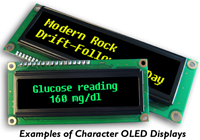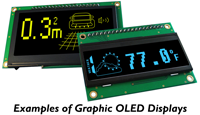The OLED (Organic Light Emitting Diode) is a brighter, higher contrast display that has faster response times, wider viewing angles, and consumes less power than conventional VFD, LED or LCD Displays. OLED displays are self-illuminating and require no backlight for maximum visibility in all environments. This also allows OLEDs to be significantly thinner than standard VFD, LED or LCD displays. Newhaven Display offers Character and Graphic type OLED displays as complete, easy-to-use modules.
Character OLED modules come in standard sizes and can be used as compatible replacements for LCD or VFD modules. They use serial or parallel MPU interfaces, have LCD compatible instructions and 4 built-in font tables.

Graphic OLED modules are easy to use, all-in-one designs. Most Graphic OLED displays require multiple high-voltage power supplies and external logic components. Newhaven Display's custom designed module boards for each Graphic OLED allow the user to have just one interface supply. The Graphic OLED module board has all the required external logic components, making it fast and easy to start using the displays.

Fast response time: 10μs
Wide viewing angle: Up to 160°
Thin designs
Self-illuminated; no backlight necessary
Low power consumption
High brightness
High contrast ratio: 2000:1
Wide operation temperature: -40°C to +80°C
Serial or Parallel MPU interface
Character Module OLEDs include 4 built-in font tables
Graphic Module OLEDs include required external logic and voltages
RoHS Compliant
OLED Display Structure
OLED Displays (Organic Light Emitting Diode) provide brighter, higher contrast displays, have faster response times, wider viewing angles and use less power than the conventional LED or LCD displays.
OLED Displays are made up of a layer of organic material placed between two conductors. These two conductors (an anode and a cathode) are then between a glass top plate (seal) and a glass bottom plate (substrate). When an electric current is applied to the two conductors, the organic material produces a bright, electro-luminescent light. When energy passes from the negatively charged layer (cathode) to the other (anode) layer, it stimulates the organic material between the two, which in turns emits lights that is visible through the outermost layer of glass.
How OLEDs Produce Color
In order for OLED displays to product color, an electric current is needed to stimulate the relevant pixels on the OLED display. The pixels are created by the arrangement of the cathodes and anodes; which are arranged perpendicular to each other. The electric current applied to the selected strips of anodes and cathodes determine which pixels get turned on and which pixels remain off. The brightness of each pixel is proportional to the amount of applied current.

